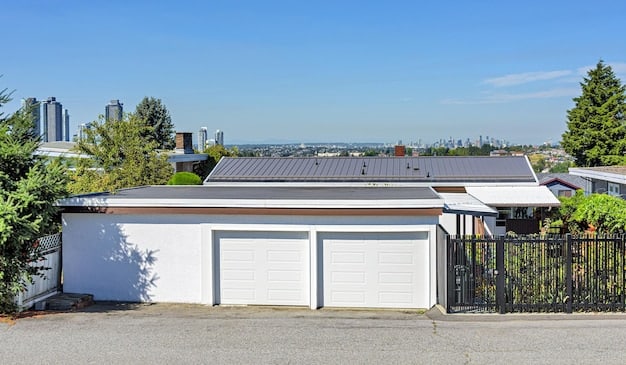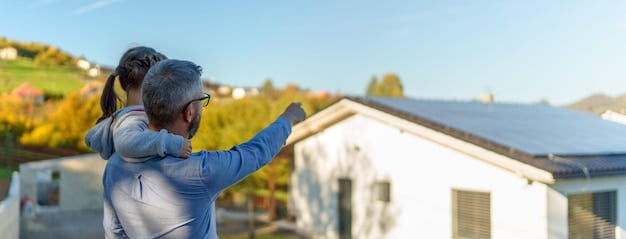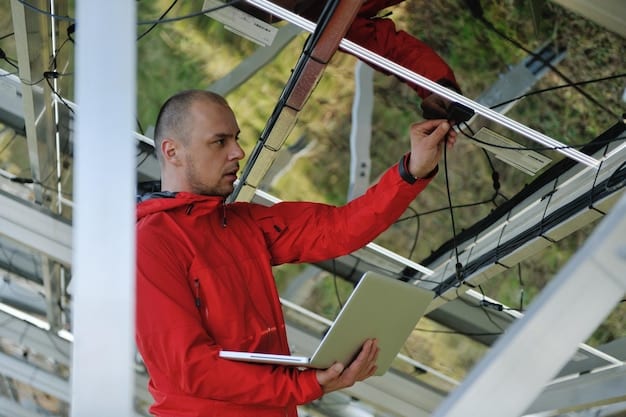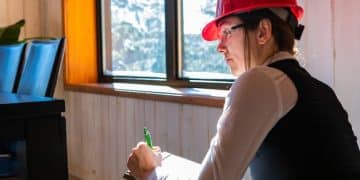DIY Solar Panel Installation: Slash Your 2025 Electricity Bills!

DIY Solar Panel Installation can significantly reduce electricity bills, potentially by up to 50% by 2025, offering a cost-effective and environmentally friendly way to generate your own power and gain energy independence.
Embarking on a DIY solar panel installation project is a smart move for homeowners looking to reduce their carbon footprint and save money. By 2025, with advancements in technology and decreasing costs, installing your own solar panels could slash your electricity bill by up to 50%! Let’s explore how you can achieve energy independence and significant savings.
Is DIY Solar Panel Installation Right for You?
Deciding whether to install your own solar panels is a significant decision. It involves weighing the benefits against the challenges and considering your personal circumstances.
Assessing Your Home’s Suitability
Before diving into the project, evaluate your home’s potential for solar energy. Key factors include roof orientation, angle, and shading.
DIY vs. Professional Installation: A Quick Comparison
Consider the pros and cons of both approaches. DIY offers cost savings, while professional installation provides expertise and warranty.
- Cost: DIY is generally cheaper due to the absence of labor costs.
- Time: DIY requires a significant time investment for research, installation, and inspection.
- Expertise: Professional installers bring experience and knowledge to the table.
- Warranty: Professional installations often come with warranties covering equipment and workmanship.
Ultimately, the best choice depends on your budget, skills, and comfort level. Research thoroughly, and don’t hesitate to consult with experts if needed.
Careful planning and preparation are essential for successful DIY solar panel installation. Evaluating your home’s suitability and weighing the pros and cons of DIY versus professional installation will pave the way for a smooth and rewarding experience.

Planning Your DIY Solar Panel Project
Careful planning is the cornerstone of any successful DIY solar panel installation. This phase involves assessing your energy needs, understanding local regulations, and designing your system.
Calculating Your Energy Needs
Start by analyzing your electricity bills for the past year. This will give you a clear picture of your average energy consumption.
Understanding Local Regulations and Permits
Research local building codes and regulations regarding solar panel installations. Obtaining the necessary permits is crucial to avoid future legal issues.
Designing Your Solar Panel System
Determine the number of solar panels you’ll need based on your energy consumption and the available roof space. Consider using online solar calculators for estimations.
- Panel Size: Choose panels that fit your space and energy needs efficiently.
- Inverter Compatibility: Ensure your inverter is compatible with your solar panels.
- Wiring and Connections: Plan for proper wiring and connections to ensure safety and efficiency.
Detailed planning is essential for a smooth DIY solar panel installation. Calculating your energy needs, understanding local regulations, and carefully designing your system will lay the groundwork for success.
Essential Tools and Equipment for DIY Solar Installation
Having the right tools and equipment is crucial for a safe and efficient DIY solar panel installation. Here’s a comprehensive checklist of what you’ll need.
Safety Gear
Prioritize safety by investing in essential protective gear, including a hard hat, safety glasses, gloves, and a safety harness.
Mounting Hardware
Choose the appropriate mounting hardware based on your roof type. Options include roof mounts, ground mounts, and pole mounts.
Electrical Components
Gather the necessary electrical components, such as wiring, connectors, inverters, and charge controllers.
- Solar Panels: Choose high-quality panels with a good warranty.
- Inverter: Select an inverter that matches your system’s voltage and power requirements.
- Wiring: Use appropriately sized wiring to handle the electrical load.
Investing in the right tools and equipment will not only make the installation process easier but also ensure your safety. Don’t compromise on quality, especially when it comes to safety gear and electrical components.
Installing Your Solar Panels: A Step-by-Step Guide
The installation process involves several key steps, from mounting the panels to connecting the electrical components. Follow this guide carefully for a successful installation.
Mounting the Solar Panels
Securely attach the mounting hardware to your roof, following the manufacturer’s instructions. Ensure the panels are properly aligned and angled for optimal sunlight exposure.
Wiring the Solar Panels
Connect the solar panels in series or parallel, depending on your system’s design. Use appropriate wiring and connectors to ensure a secure and weatherproof connection.
Connecting to the Inverter
Connect the solar panels to the inverter, which converts DC electricity into AC electricity for use in your home. Follow the inverter manufacturer’s instructions carefully.
Proper installation is key to maximizing the performance and lifespan of your solar panels. Take your time, follow the instructions carefully, and don’t hesitate to seek help if needed.

Ensuring Safety During and After Installation
Safety is paramount throughout the DIY solar panel installation process and beyond. Here’s how to mitigate risks and ensure a safe operating system.
Electrical Safety Precautions
Always disconnect the power before working on any electrical components. Use insulated tools and wear appropriate safety gear to prevent electric shock.
Roof Safety Measures
Use a safety harness when working on the roof. Secure ladders and scaffolding to prevent falls. Work in dry conditions to avoid slips.
Regular Maintenance and Inspections
Inspect your solar panels regularly for any signs of damage or wear. Clean the panels to remove dirt and debris, which can reduce their efficiency.
- Check Wiring: Inspect wiring for any loose connections or frayed wires.
- Monitor Performance: Monitor your system’s performance to identify any potential issues early on.
- Professional Inspection: Consider a professional inspection every few years to ensure everything is in good working order.
Prioritizing safety is essential for your well-being and the longevity of your solar panel system. By taking the necessary precautions and performing regular maintenance, you can enjoy the benefits of solar energy safely and reliably.
Maximizing Your Savings and Energy Independence
Once your solar panels are installed, there are several ways to maximize your savings and achieve greater energy independence.
Net Metering Programs
Take advantage of net metering programs, which allow you to sell excess electricity back to the grid, further reducing your electricity bill.
Energy Storage Solutions
Consider adding battery storage to your system, allowing you to store excess energy for use during power outages or at night.
Energy-Efficient Practices
Adopt energy-efficient practices in your home, such as using LED lighting, upgrading appliances, and improving insulation, to reduce your overall energy consumption.
By taking advantage of net metering programs, investing in energy storage solutions, and adopting energy-efficient practices, you can maximize your savings and achieve greater energy independence. Solar energy is not just about reducing your electricity bill; it’s about creating a sustainable future.
| Key Point | Brief Description |
|---|---|
| 💡 Energy Needs | Calculate your energy usage to size your system correctly. |
| 🛠️ Essential Tools | Gather necessary tools, including safety gear and mounting hardware. |
| ⚡ Safety First | Prioritize safety with proper precautions and regular inspections. |
| 💰 Maximize Savings | Use net metering, storage, and efficiency for optimal cost reduction. |
Frequently Asked Questions
▼
The primary benefits include significant cost savings on labor, increased control over the installation process, and the satisfaction of building your own renewable energy system. Plus, you’ll reduce your carbon footprint.
▼
Risks include electrical shock, falls from the roof, improper installation leading to system inefficiencies or damage, and voiding manufacturer warranties if installation guidelines aren’t followed carefully. Safety is paramount.
▼
Analyze your past electricity bills to determine your average energy consumption. Use online solar calculators and consult with solar experts to estimate the number of panels needed based on your roof’s orientation and sunlight exposure.
▼
Yes, many states and the federal government offer tax credits and rebates for solar installations, including DIY projects. Check the Database of State Incentives for Renewables & Efficiency (DSIRE) for information on incentives in your area.
▼
Always follow local building codes and regulations. Obtain necessary permits before starting. Consult with a qualified electrician to review your plans and inspect your work. Prioritize safety by using proper equipment and following electrical safety guidelines.
Conclusion
Embarking on a DIY solar panel installation project can be a rewarding experience, offering significant savings on your electricity bill and promoting energy independence. By carefully planning your project, prioritizing safety, and staying informed about local regulations, you can successfully harness the power of solar energy and contribute to a more sustainable future. Remember to research thoroughly and seek professional guidance when needed to ensure a safe and efficient installation.





